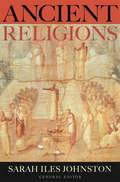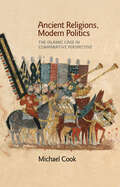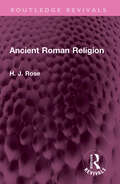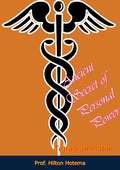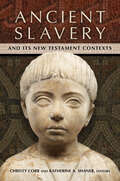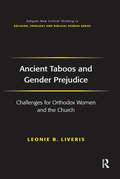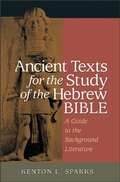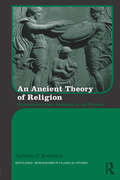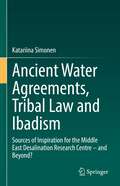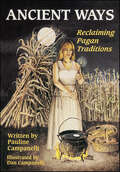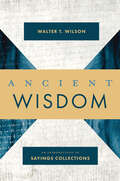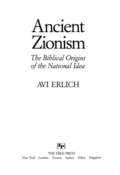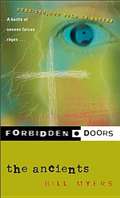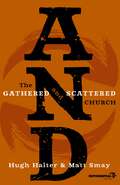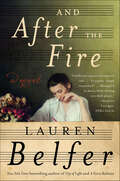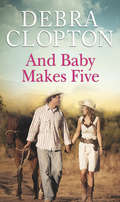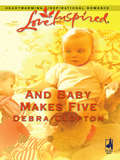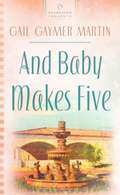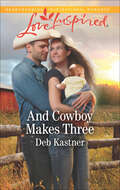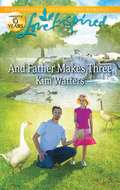- Table View
- List View
Ancient Religions: A Guide (Blackwell Ancient Religions Ser. #8)
by Sarah Iles JohnstonReligious beliefs and practices, which permeated all aspects of life in antiquity, traveled well-worn routes throughout the Mediterranean: itinerant charismatic practitioners journeying from place to place peddled their skills as healers, purifiers, cursers, and initiators; and vessels decorated with illustrations of myths traveled with them. New gods encountered in foreign lands by merchants and conquerors were sometimes taken home to be adapted and adopted. This collection of essays by a distinguished international group of scholars, drawn from the groundbreaking reference work Religions of the Ancient World, offers an expansive, comparative perspective on this complex spiritual world.
Ancient Religions (Blackwell Ancient Religions Ser. #3)
by Sarah Iles JohnstonReligious beliefs and practices, which permeated all aspects of life in antiquity, traveled well-worn routes throughout the Mediterranean: itinerant charismatic practitioners journeying from place to place peddled their skills as healers, purifiers, cursers, and initiators; and vessels decorated with illustrations of myths traveled with them. New gods encountered in foreign lands by merchants and conquerors were sometimes taken home to be adapted and adopted. This collection of essays by a distinguished international group of scholars, drawn from the groundbreaking reference work Religions of the Ancient World, offers an expansive, comparative perspective on this complex spiritual world.
Ancient Religions, Modern Politics: The Islamic Case in Comparative Perspective
by Michael A. CookWhy Islam is more political and fundamentalist than other religionsWhy does Islam play a larger role in contemporary politics than other religions? Is there something about the Islamic heritage that makes Muslims more likely than adherents of other faiths to invoke it in their political life? If so, what is it? Ancient Religions, Modern Politics seeks to answer these questions by examining the roles of Islam, Hinduism, and Christianity in modern political life, placing special emphasis on the relevance—or irrelevance—of their heritages to today's social and political concerns.Michael Cook takes an in-depth, comparative look at political identity, social values, attitudes to warfare, views about the role of religion in various cultural domains, and conceptions of the polity. In all these fields he finds that the Islamic heritage offers richer resources for those engaged in current politics than either the Hindu or the Christian heritages. He uses this finding to explain the fact that, despite the existence of Hindu and Christian counterparts to some aspects of Islamism, the phenomenon as a whole is unique in the world today. The book also shows that fundamentalism—in the sense of a determination to return to the original sources of the religion—is politically more adaptive for Muslims than it is for Hindus or Christians.A sweeping comparative analysis by one of the world's leading scholars of premodern Islam, Ancient Religions, Modern Politics sheds important light on the relationship between the foundational texts of these three great religious traditions and the politics of their followers today.
The Ancient Roman Afterlife: Di Manes, Belief, and the Cult of the Dead
by Charles W. KingIn ancient Rome, it was believed some humans were transformed into special, empowered beings after death. These deified dead, known as the manes, watched over and protected their surviving family members, possibly even extending those relatives’ lives. But unlike the Greek hero-cult, the worship of dead emperors, or the Christian saints, the manes were incredibly inclusive—enrolling even those without social clout, such as women and the poor, among Rome's deities. The Roman afterlife promised posthumous power in the world of the living. While the manes have often been glossed over in studies of Roman religion, this book brings their compelling story to the forefront, exploring their myriad forms and how their worship played out in the context of Roman religion’s daily practice. Exploring the place of the manes in Roman society, Charles King delves into Roman beliefs about their powers to sustain life and bring death to individuals or armies, examines the rituals the Romans performed to honor them, and reclaims the vital role the manes played in the ancient Roman afterlife.
The Ancient Roman Afterlife: Di Manes, Belief, and the Cult of the Dead
by Charles W. KingA comprehensive study of the manes, their worship, and their place in Roman conceptions of their society.In ancient Rome, it was believed some humans were transformed into special, empowered beings after death. These deified dead, known as the manes, watched over and protected their surviving family members, possibly even extending those relatives&’ lives. But unlike the Greek hero-cult, the worship of dead emperors, or the Christian saints, the manes were incredibly inclusive—enrolling even those without social clout, such as women and the poor, among Rome&’s deities. The Roman afterlife promised posthumous power in the world of the living.While the manes have often been glossed over in studies of Roman religion, this book brings their compelling story to the forefront, exploring their myriad forms and how their worship played out in the context of Roman religion&’s daily practice. Exploring the place of the manes in Roman society, Charles King delves into Roman beliefs about their powers to sustain life and bring death to individuals or armies, examines the rituals the Romans performed to honor them, and reclaims the vital role the manes played in the ancient Roman afterlife.&“King ranges widely across literary genres, law, epigraphy, and archaeology. He provides a thorough, rigorous, and well-documented study of an aspect of Roman religion and culture that, despite its importance, has so far not received due attention.&” —James B. Rives, author of Religion in the Roman Empire&“Groundbreaking . . . An invaluable resource for scholars of religion, funerary practice and afterlife in ancient Rome and more generally . . . King aims to use his model of variability in Roman belief to show the cult of the dead as inclusive of all Romans, living and deceased. Through extensive literary evidence and select cross-cultural comparisons, he largely succeeds. This stands to become a foundational text.&” —Antiquity&“King presents many attractive impressions of Roman society in his study . . . King&’s major thesis—that Romans regarded their dead as gods, thought about them, communicated with them, attended to them, and intended to join them—is conclusively presented.&” —Bryn Mawr Classical Review
Ancient Roman Religion (Routledge Revivals)
by H. J. RoseFirst published in 1949, Ancient Roman Religion is an introduction to some of the most outstanding features of the complicated religion, or rather series of religions, which flourished in Rome between the earliest recoverable ages of her long history and the close of the classical epoch. This book will be of interest students of religion, literature and history.
Ancient Secret of Personal Power: Tetragrammaton
by Hilton HotemaIn the Great Mystic Symbolic Tetragrammaton of the Ancient Masters we have one of their deepest secrets; the discovery of what the Masters called the Sacred Four Elements, as they found that these elements enter into the constitution of everything known.Earth, Water, Air, and Fire are the elements that produce every formation, every object, every organism. The Masters then invented an appropriate symbol to embrace the Sacred Four Elements. This symbol is known to us as the Sphinx, the image of which has been found in all the lands of the ancient world, and just as far back in the night of time as it is possible for us to go.Professor Hilton Hotema again raises compelling questions regarding our physical, spiritual, and mental reactions to these Sacred Four Elements.
Ancient Slavery and Its New Testament Contexts
by Christy CobbAn essential resource for understanding slavery in the New Testament and early Christianity Slavery permeated society in the ancient world. The realities of slavery and its shadows pervade the New Testament and other early Christian texts. Yet enslavement remains an under-taught aspect of the context of the New Testament and early Christianity. Because of this, readers are left with numerous questions about ancient slavery. How did people become enslaved? What kinds of work did enslaved people do? Who enslaved people? How did ancient slavery compare with more contemporary enslavement eras? Did anyone in the ancient world criticize slavery? Was ancient slavery racialized? Did Christians have a different understanding of slavery than others? These are just some of the questions students ask in higher education and in Bible study classrooms alike. This volume takes on these questions, introducing students to the textures, complexities, and material realities of slavery in the Greco-Roman world. Ancient Slavery and Its New Testament Contexts draws on the expertise of scholars around the world with a focus on introductory information, accessibility, and readability. It does not attempt to dismiss or downplay the role of New Testament texts in the perpetuation of either ancient slavery or slavery in the North American context. Rather, the volume helps students and teachers alike wrestle with the ongoing historical, theological, and ethical legacies of slavery in their own faith formation and engagement with the biblical text.
Ancient Taboos and Gender Prejudice: Challenges for Orthodox Women and the Church (Routledge New Critical Thinking in Religion, Theology and Biblical Studies)
by Leonie B. LiverisThis book explores the struggling genesis of a women's movement in the Orthodox Church through the ecumenical movement of the twentieth century at a time when militant conservatism is emerging in Orthodox countries and fundamentalism in the diaspora. Offering an understanding of the participation of women in the Orthodox Church, particularly during the 50 years of the membership of the Orthodox churches in the World Council of Churches, this book contributes to the ongoing debates and feminist analysis of women's participation, ministry and sexuality in the life and practice of the Church universal. The book reveals both the positive contributions to ecumenism and the difficulties confronting Orthodox women wishing to participate more fully in the leadership and ministry of their church.
Ancient Texts for the Study of the Hebrew Bible: A Guide to the Background Literature
by Kenton L. SparksThe Hebrew Bible represents no mere collection of books but a stunning array of literary genres. To fully illuminate the history and culture of the Old Testament, it is necessary to compare these ancient writings to similar texts written concurrently by Israel's neighbors. Beginning with an overview of the important literary archives of the ancient Near East, Sparks provides exhaustive references to the ancient literary counterparts to the Hebrew Bible's major genres. Surveying the ancient writings found throughout Egypt, Mesopotamia, Anatolia, and Palestine, Sparks provides a brief summary of each text discussed, translating brief portions and linking them to literarily similar biblical passages. Exploring over thirty genres--wisdom, hymns, love poetry, rituals, prophecy, apocalyptic, novella, epic legend, myth, genealogy, history, law, treaty, epigraphic materials, and others--it offers an exemplary guide to the fertile literary environment from which the canonical writings sprung. Rich with bibliographic material, this invaluable catalog enables the reader to locate not only the published texts in their original ancient languages but to find suitable English translations and commentary bearing on these ancient texts. A number of helpful indexes round out this outstanding resource. Providing students with a thorough introduction to the literature of the ancient Near East--and time-pressed scholars with an admirably up-to-date research tool--it will become a syllabus standard for a myriad of courses.
An Ancient Theory of Religion: Euhemerism from Antiquity to the Present (Routledge Monographs in Classical Studies)
by Nickolas RoubekasAn Ancient Theory of Religion examines a theory of religion put forward by Euhemerus of Messene (late 4th—early 3rd century BCE) in his lost work Sacred Inscription, and shows not only how and why euhemerism came about but also how it was— and still is—used. By studying the utilization of the theory in different periods—from the Graeco-Roman world to Late Antiquity, and from the Renaissance to the twenty-first century—this book explores the reception of the theory in diverse literary works. In so doing, it also unpacks the different adoptions and misrepresentations of Euhemerus’s work according to the diverse agendas of the authors and scholars who have employed his theory. In the process, certain questions are raised: What did Euhemerus actually claim? How has his theory of the origins of belief in gods been used? How can modern scholarship approach and interpret his take on religion? When referring to ‘euhemerism,’ whose version are we employing? An Ancient Theory of Religion assumes no prior knowledge of euhemerism and will be of interest to scholars working in classical reception, religious studies, and early Christian studies.
The Ancient Tradition of Angels: The Power and Influence of Sacred Messengers
by Normandi EllisAn in-depth study into the mystery and purpose of angels• Explains that angels are beings of light consciousness, here to help our individual and planetary cosmic evolution• Explores angels from Judeo-Christian and Islamic faiths, Hinduism and Buddhism, the beliefs of ancient Egypt, Yezidism, and Zoroastrianism as well as what Theosophists, Kabbalists, Sufi masters, Eastern gurus, and modern mystics like Edgar Cayce have recounted about angels• Examines contemporary angelic encounters, including the author&’s own interactions with angels, and also looks at the purpose of dark angels and fallen angelsFrom the divine messengers of Western traditions to the devas of Eastern traditions to the meleks and spirit beings found along the Silk Road, angels are one of the unifying themes of theology worldwide. But what is an angel, and why do they contact us, believers and nonbelievers alike?In this in-depth study into the mystery and purpose of angels, Normandi Ellis looks at the angelic dimensions of spiritual traditions around the world—from the ancient past to present day. She explores well-known angels from Judeo-Christian and Islamic faiths, the Hindu devata and Buddhist spirit beings, the spirit beings of ancient Egypt, the Peacock Angel of Yezidism, and the yazatas of Zoroastrianism. She compares angelic visions from medieval Christians like Thomas Aquinas and John of Damascus with what Theosophists, kabbalists, Sufi masters, Eastern gurus, and modern mystics like Edgar Cayce have recounted about angels. She looks at dark and fallen angels and their role in the grand cosmological plan. Quoting from sacred traditions, narrative myth, and contemporary angelic encounters, including her own personal interactions with angels, the author clarifies the divergent aspects of angelic beliefs but also reveals the common points shared by all traditions. Ellis shows how, in whatever guise they appear, angels are messengers. She explains that angels are beings of light consciousness, part of the universal life force that connects all beings. And not only are angels actively helping in our planet&’s cosmic evolution, they also help us see our own place in the cosmic plan.
Ancient Water Agreements, Tribal Law and Ibadism: Sources of Inspiration for the Middle East Desalination Research Centre – and Beyond?
by Katariina SimonenThis book traces the development of Oman's inclusive agreements and highlights their importance for international negotiations, dealing with issues most relevant to humanity's own survival today, nuclear weapons or climate change.In Oman, a historical seafaring nation on the south-eastern corner of the Arabian Peninsula, a culture of agreement that accommodates the interests of everyone has developed around the division of scarce water resources.Life in the arid inland of the Omani Hajar mountains would not have been possible without water. Irrigation channel (falaj) construction is extremely old and skilful therein. Local practices evolved around the division of water and land on the basis of fairness. The community would be best served by inclusion and the avoidance of conflict.A specific Islamic school called Ibadi arrived at Oman early on in the eighth century. Ibadi scholars conserved local practices. Consultation and mediation by sheikhs and the religious leader, Imam, became the law of the land. The Omanis were known as the People of Consultation, Ahl Al Shura. In time, the practice of inclusive agreements would extend far beyond the village level, affecting Oman´s foreign policy under Sultan Qaboos. Oman´s water diplomacy succeeded in uniting the contestants of the Middle East Peace Process in the 1990s to work together on common problems of water desalination.
Ancient Ways: Reclaiming the Pagan Tradition
by Pauline CampanelliPauline and Dan Campanelli's classic companion to Wheel of the Year is back for a new generation of readers to enjoyCelebrate the seasons of the year according to the ancient Pagan traditions. Ancient Ways shows how to prepare for and conduct the Sabbat rites, and helps you harness the magickal energy for weeks afterward. The wealth of seasonal rituals and charms within are drawn from ancient sources but are easily performed with readily available materials.Learn how to look into your previous lives at Yule. At Beltane, discover the places where you are most likely to see faeries. Make special jewelry to wear for your Lammas celebrations. For the special animals in your life, paint a charm of protection at Midsummer.Most Pagans feel that the Sabbat rituals are all too brief and wish for the magick to continue. Ancient Ways can help you reclaim your own traditions and heighten the feeling of magick all year long.Praise: "A delightful, joyous guide to celebrating the seasons and festivals with homespun magic." —Scott Cunningham, author of Cunningham's Encyclopedia of Magical Herbs "A delightful book that beautifully complements the authors' Wheel of the Year." —Ray Buckland, author of Practical Candleburning Rituals
Ancient Wisdom: An Introduction to Sayings Collections (Wisdom Literature From The Ancient World Ser. #1)
by Walter T. WilsonThis book surveys and analyzes twenty-seven major collections of wisdom sayings from antiquity, including texts from ancient Egypt, the ancient Near East, ancient Israel and early Judaism, early Christianity, and the Greco-Roman world. Through the diversity of these selections, readers are exposed to wisdom literature from a wide array of historical, cultural, and linguistic settings, which unfolds into a larger understanding of how different ancient peoples articulated a gnomic understanding of life. Throughout this useful guide, Walter Wilson keeps a constant eye on the relation of the wisdom texts to the worlds from which they emerged—paying close attention to each text&’s distinctive thematic profile and how its moral agenda was mapped onto the reader&’s social landscape. Where appropriate, he discusses affinities between the different collections and draws conclusions about ancient wisdom literature as a genre. For further study, each entry includes a short bibliography directing the reader to an up-to-date translation of the collection in question and other relevant secondary texts, making this an ideal starting point for anyone studying wisdom literature of the ancient world.
Ancient Zionism: The Biblical Origins of the National Idea
by Avi ErlichThe ancient Hebrews, Erlich argues, invented a unique basis for social unity by forging an imaginative link between religion (or law), literary culture, and the specific land of Israel. In this conception, the land, the law, and the people of Israel are one, a living metaphor expressed in the idea of Zion. The unity of land, law, and literature created by the Hebrews has been one of the most potent historical metaphors ever devised, strong enough to maintain a sense of national identity among Jews for over two thousand years. Without this Jewish literary culture, Erlich argues, there could have been no state of Israel, no matter what efforts were made by modern Zionist ideologues. This book reads the ancient text with ancient eyes that make it startling and fresh for those conditioned to the "modern" view of national identity as based on either race or ideology. Modern Zionism, like modern nationalism generally, is a drastically impoverished descendant of this original Jewish nationalism, and Erlich concludes that many problems not only of Israel but of all modern nations struggling to define themselves in a changing world really stem from the loss of this vigorous ancient alternative.
The Ancients (Forbidden Doors, #10)
by Bill Myers James RiordanSwift Arrow has angered the gods with his lies! He must be driven from the tribe!" When Scott and Rebecca Williams are sent, along with their mom and Ryan, to a remote mountain village in New Mexico, they don't know what to expect. Their Internet friend Z has simply asked them to help a young brave named Swift Arrow. What they find in the small village is an evil so powerful that it attacks them with wind, thunder, lightning - even the very ground they walk on. But none of that is as frightening as the evil invading the heart and mind of one of their own. Now the battle is on, and the stakes are higher than ever before. Not only must they fight to defeat the evil threatening their new friend, but they must work together to restore truth-and save one they love. This is book 10 in the Forbidden Doors series.
AND: The Gathered and Scattered Church (Exponential Series)
by Matt Smay Hugh HalterWhat is happening to the church in America today? By all appearances, it looks like we are “doing’ church better than we ever have. Our programs are effective, our pastors are relevant, and our buildings are increasing in size. In the past 30 years the number of mega-churches has increased from under 100 to over 7,500. In the past 10 years the number of multi-site churches has increased from under 100 to over 2,000. By the numbers, these church movements enjoy the national platform, the national voice, and the resources to profoundly impact the Kingdom. But to what end? In spite of the rapid growth of these prevailing church movements we are still losing ground, and the church in the west is in massive decline. Numerous studies and books have been written documenting the flight of members from the institutional church. Yet the local church is Jesus’ plan for reaching the world. The strength of the mega-church and multi-site models can be found in a strong emphasis on attracting people to the church, where they have an opportunity to encounter Jesus Christ. Yet many younger leaders are rejecting this model in favor of a more incarnational approach to ministry. These missional communities tend to focus their attention on trying to release people into ministry. In recent years a growing schism has emerged between those calling themselves incarnational leaders and those leading the prevailing church models. But what if we were able to incorporate the insights of both models into a cohesive understanding of the church? Can we bring together the very best of the attractional AND missional models for church ministry? What is needed is not is another book about how to do church better. Our focus on the form church is misguided when the vast majority of unchurched Christians and non-believers aren’t moving toward any form of church. Beautifully Sent will give permission for leaders to value existing church forms while catalyzing a missional movement of incarnational people into the world.
And After the Fire: A Novel
by Lauren BelferNational Jewish Book Award WinnerThe New York Times bestselling author of A Fierce Radiance and City of Light returns with a powerful and passionate novel—inspired by historical events—about two women, one European and one American, and the mysterious choral masterpiece by Johann Sebastian Bach that changes both their lives.In the ruins of Germany in 1945, at the end of World War II, American soldier Henry Sachs takes a souvenir, an old music manuscript, from a seemingly deserted mansion and mistakenly kills the girl who tries to stop him.In America in 2010, Henry’s niece, Susanna Kessler, struggles to rebuild her life after she experiences a devastating act of violence on the streets of New York City. When Henry dies soon after, she uncovers the long-hidden music manuscript. She becomes determined to discover what it is and to return it to its rightful owner, a journey that will challenge her preconceptions about herself and her family’s history—and also offer her an opportunity to finally make peace with the past.In Berlin, Germany, in 1783, amid the city’s glittering salons where aristocrats and commoners, Christians and Jews, mingle freely despite simmering anti-Semitism, Sara Itzig Levy, a renowned musician, conceals the manuscript of an anti-Jewish cantata by Johann Sebastian Bach, an unsettling gift to her from Bach’s son, her teacher. This work and its disturbing message will haunt Sara and her family for generations to come.Interweaving the stories of Susanna and Sara, and their families, And After the Fire traverses over two hundred years of history, from the eighteenth century through the Holocaust and into today, seamlessly melding past and present, real and imagined. Lauren Belfer’s deeply researched, evocative, and compelling narrative resonates with emotion and immediacy.
And Baby Makes Five
by Debra CloptonRe-read a fan-favorite Mule Hollow story by bestselling author Debra Clopton Take two stubborn humans. Add his dog, her donkey--and a brand new baby. A donkey with a penchant for breaking and entering? Cort Wells had never heard of such a thing, until he and his dog moved to Mule Hollow, Texas. Soon he found out the donkey's owner was Lilly Tipps, eight months pregnant and raised by her man-hating grandmas. So when one day Lilly wound up in his barn--and his arms--Cort began to think the donkey was going to be the least of his worries…. Originally published in 2006
And Baby Makes Five
by Debra CloptonTWO STUBBORN HUMANS, HIS DOG, HER DONKEY . . . ; AND A BRAND-NEW BABYA donkey with a penchant for breaking and entering. . . ;in search of alfalfa? Cort Wells had never heard of such a thing, until he and his dog moved into Mule Hollow. And the donkey's eight-months-pregnant owner was Lilly Tipps, raised by her man-hating grandmas. So when Lilly wound up in his barn - and his arms - Cort began to think the donkey was going to be the least of his worries. . . . ;
And Baby Makes Five
by Gail Gaymer MartinThis is not what Felisa Carrillo envisioned when she left her home in Guadalajara. Sixteen, married to a handsome guy, heading to America. Who could have know her husband would turn abusive and "America" would mean migrant work and impoverished living? But here she is, years later, wiser but still in trouble. Chad Garrison is on a routine visit to his fields when he sees a young migrant worker double over in pain. He hurries to help, only to find she is about to deliver a child there in his field. He rushes her to the hospital, then finds himself drawn to her. Is Chad being taken in by a scheming, dishonest immigrant, as some of his friends suggest? Should Felisa be concerned that Chad has ulterior motives in his generosity toward her? Is this relationship God's doing or just a big mistake?
And China Has Hands
by H. T. TsiangH. T. Tsiang’s And China Has Hands is a poignant and groundbreaking novel that explores the themes of race, class, and identity through the eyes of Wong Wan-Lee, a Chinese immigrant navigating life in Depression-era America. Written with sharp wit and unflinching honesty, this novel captures the struggles of marginalized communities striving for dignity and purpose in an unforgiving world.At the heart of the story is Wong’s journey as he searches for a sense of belonging and meaning while enduring exploitation, discrimination, and cultural alienation. Through his relationships, encounters with labor struggles, and reflections on his homeland, Wong becomes a lens through which Tsiang examines broader societal inequalities and the universal longing for justice and equality.Tsiang’s prose is both lyrical and biting, blending satire and earnest critique to create a vivid portrayal of immigrant life during one of America’s most turbulent eras. His narrative challenges stereotypes and questions the barriers erected by prejudice, while celebrating the resilience and humanity of those forced to fight against systemic oppression.And China Has Hands is a powerful testament to the enduring strength of the human spirit and the complexities of the immigrant experience. Often overlooked in its time, this novel remains a vital piece of literature, offering timeless insights into the struggles and triumphs of those who bridge cultures and defy expectations.For readers interested in social justice, immigrant narratives, and the history of Chinese-American literature, And China Has Hands is a deeply moving and thought-provoking work that resonates as strongly today as it did upon its original publication.
And Cowboy Makes Three (Cowboy Country #7)
by Deb KastnerShe fled their wedding years agoNow she’s back…with a baby!Coming home with a baby and no wedding ring was just what everyone in Cowboy Country expected from bad girl Angelica Carmichael. But she’ll brave their scorn to fulfill Granny Frances’s dying wishes, even if it means ranching with Rowdy Masterson…her jilted ex-groom. Rowdy’s still bitter but this new, softer Angelica—paired with a precious baby—might be too loveable to resist!
And Father Makes Three
by Kim WattersShe's saved countless lives, yet there's one person emergency room doctor Elizabeth Randall can't rescue-her adopted daughter, Jordan. Perhaps meeting her biological father, Blake Crawford, will be the lifeline Jordan needs. The handsome, guarded firefighter takes risks every day. But facing the daughter he never knew-along with lovely Elizabeth-has him thinking about family. With fatherhood thrust suddenly upon him, there's no way he can turn his back on his sick child. Will working together to give Jordan a second chance at life also lead them to a chance at love?
